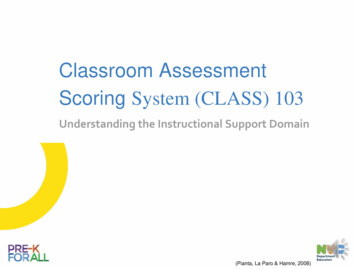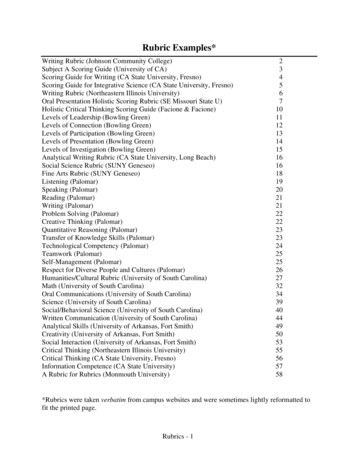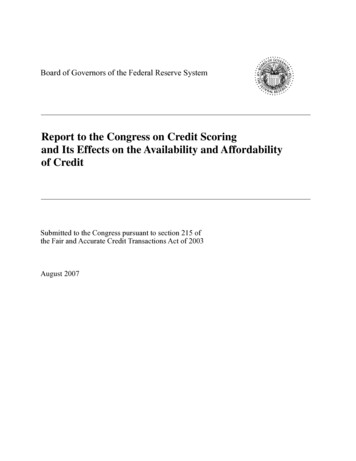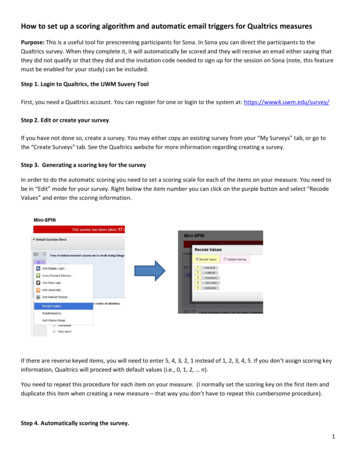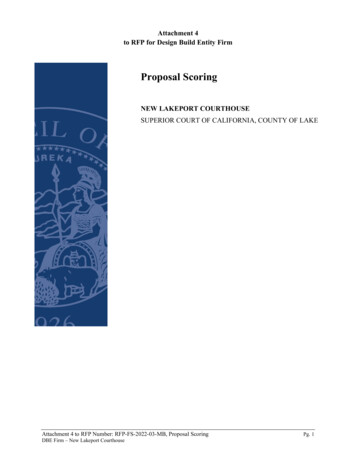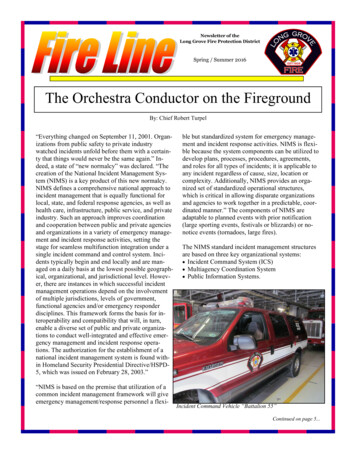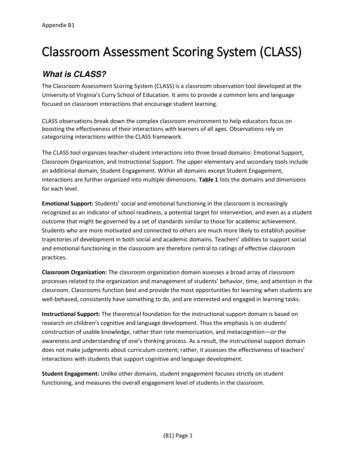
Transcription
Appendix B1Classroom Assessment Scoring System (CLASS)What is CLASS?The Classroom Assessment Scoring System (CLASS) is a classroom observation tool developed at theUniversity of Virginia’s Curry School of Education. It aims to provide a common lens and languagefocused on classroom interactions that encourage student learning.CLASS observations break down the complex classroom environment to help educators focus onboosting the effectiveness of their interactions with learners of all ages. Observations rely oncategorizing interactions within the CLASS framework.The CLASS tool organizes teacher-student interactions into three broad domains: Emotional Support,Classroom Organization, and Instructional Support. The upper elementary and secondary tools includean additional domain, Student Engagement. Within all domains except Student Engagement,interactions are further organized into multiple dimensions. Table 1 lists the domains and dimensionsfor each level.Emotional Support: Students’ social and emotional functioning in the classroom is increasinglyrecognized as an indicator of school readiness, a potential target for intervention, and even as a studentoutcome that might be governed by a set of standards similar to those for academic achievement.Students who are more motivated and connected to others are much more likely to establish positivetrajectories of development in both social and academic domains. Teachers’ abilities to support socialand emotional functioning in the classroom are therefore central to ratings of effective classroompractices.Classroom Organization: The classroom organization domain assesses a broad array of classroomprocesses related to the organization and management of students’ behavior, time, and attention in theclassroom. Classrooms function best and provide the most opportunities for learning when students arewell-behaved, consistently have something to do, and are interested and engaged in learning tasks.Instructional Support: The theoretical foundation for the instructional support domain is based onresearch on children’s cognitive and language development. Thus the emphasis is on students’construction of usable knowledge, rather than rote memorization, and metacognition—or theawareness and understanding of one’s thinking process. As a result, the instructional support domaindoes not make judgments about curriculum content; rather, it assesses the effectiveness of teachers’interactions with students that support cognitive and language development.Student Engagement: Unlike other domains, student engagement focuses strictly on studentfunctioning, and measures the overall engagement level of students in the classroom.(B1) Page 1
Appendix B1Table 1: CLASS Domains and Pre-KLower ElementaryPositive ClimatePositive ClimateNegative ClimateNegative ClimateTeacher SensitivityTeacher SensitivityRegard for StudentPerspectivesRegard for ementProductivityProductivityInstructionalLearning FormatsInstructionalLearning FormatsUpper ElementaryPositive ClimateTeacher SensitivitySecondaryPositive ClimateTeacher SensitivityRegard for StudentPerspectivesRegard rManagementProductivityProductivityNegative ClimateNegative lysis and InquiryAnalysis and InquiryConceptDevelopmentConceptDevelopmentQuality of FeedbackQuality of FeedbackInstructional LearningFormatsInstructionalLearning FormatsLanguage ModelingLanguage ModelingQuality of FeedbackQuality of Student EngagementStudent Engagementn/an/aBased on research from the University of Virginia’s Curry School of Education and studied in thousandsof classrooms nationwide, the CLASS focuses on effective teaching helps teachers recognize and understand the power of their interactions with students aligns with professional development tools works across age levels and subjectsCLASS-based professional development tools increase teacher effectiveness, and students in classroomswhere teachers are observed to demonstrate and earn higher CLASS scores achieve at higher levels thantheir peers in classrooms with lower CLASS scores.11Teachstone Inc. http://www.teachstone.org/about-the-class/(B1) Page 2
Appendix B1CLASS and Program EvaluationAPS conducts CLASS observations for all program evaluation reports, starting in the 2010-11 school year.In the fall of 2010, the Office of Planning and Evaluation recruited retired teachers and administrators tobecome certified CLASS observers. Certification is managed by the University of Virginia. Traineesundergo in-depth training to help them use the tool effectively in the field. An assessment is used toensure that the observers have demonstrated reliability with the CLASS tool.Each observation lasts approximately 30 minutes and observers are instructed to view either thebeginning or end of a class. Ten additional minutes are provided for coding of the observation. Selfcontained classrooms that serve ESOL/HILT students or students with a disability, as well as mainstreamclassrooms with ESOL/HILT students or students with a disability, are included.CLASS ScoresCLASS dimensions are scored on a 7-point scale consisting of Low (1, 2), Mid (3, 4, 5), and High (6, 7)ranges. A score in the low range indicates an absence or lack of the behaviors associated with a givendimension, while a score in the high range indicates a high presence of such behaviors. Scores in thehigh range are desirable for all dimensions except for Negative Climate. With this dimension, the goal isa low score, or an absence of negativity.Research Foundations of CLASSThe CLASS framework is derived from developmental theory and research suggesting that interactionsbetween students and adults are the primary mechanism of child development and learning.Elementary CLASSResearch provides evidence about the types of teacher-student interactions that promote positive socialand academic development. The Classroom Assessment Scoring System (CLASS) provides a reliable,valid assessment of these interactions2Selected studies demonstrate: Higher levels of instructional support are related to preschoolers’ gains in pre-reading and math skills.3 High levels of emotional support contribute to preschoolers’ social competence in the kindergartenyear.4 High levels of emotional support are associated with growth in reading and math achievement fromkindergarten through fifth grade.5 High levels of classroom organization are associated with gains in first graders’ literacy.6 Kindergarten children are more engaged and exhibit greater self-control in classrooms offering moreeffective teacher-child interactions.72Karen LaParo, Robert Pianta, and Meghan Stuhlman, “Classroom Assessment Scoring System (CLASS): Findings from the Pre-KYear,” Elementary School Journal, 104:5, pages 409-426.3 Mashburn, Pianta, Hamre, Downer et al., Child Development,79, pages 732-749.4 Timothy Curby, Jennifer Locasale-Crouch, Timothy Konold, Robert Pianta, Carollee Howes, Margaret Burchinal et al., “TheRelations of Observed Pre-K Classrooms Quality Profiles to Children’s Academic Achievement and Social Competence,” EarlyEducation and Development, 19, pages 643-666.5 Robert Pianta, Jay Belsky, Nathan Vandergrift, Renee Houts, Fred Morrison, and NICHD-ECCRN, “Classroom Effects on Children’sAchievement Trajectories in Elementary School,” American Education Research Journal, 49, pages 365-397.6 Claire Cameron Ponitz, Sara Rimm-Kaufman, Laura Brock, and Lori Nathanson, “Contributions of gender, early schooladjustment, and classroom organizational climate to first grade outcomes,” Elementary School Journal, 110, 142-162.(B1) Page 3
Appendix B1 First-grade children at risk for school failure perform on par with peers, both socially and academically,when exposed to classrooms with effective teacher-student interactions.8Moreover, studies conducted in over 6,000 classrooms provide evidence that students in PK–5classrooms with higher CLASS ratings realize greater gains in achievement and social skill development.9Secondary CLASSResearch using the more recently developed secondary CLASS tool has shown that teachers’ skills inestablishing a positive emotional climate, their sensitivity to student needs, and their structuring of theirclassroom and lessons in ways that recognize adolescents’ needs for a sense of autonomy and control,for an active role in their learning, and for opportunities for peer interaction were all associated withhigher relative student gains in achievement.10Alignment with APS InitiativesDifferentiationThe four domains measured by the CLASS are essential in effectively differentiated classrooms. Inaddition, dimensions such as teacher sensitivity, regard for student/adolescent perspectives, andinstructional learning formats specifically address behaviors necessary for effective differentiation.Teacher Evaluation (Danielson)The CLASS tool is heavily aligned with Charlotte Danielson’s Framework for Teaching11, which sets forthstandards for teaching behaviors in the areas of planning, instruction, classroom environment, andprofessional responsibility. Danielson’s Levels of Performance rubrics are the foundation for all T-Scalestaff evaluation in APS.Cultural CompetenceThere is strong alignment between Gay’s Exemplars of Culturally Responsive Behaviors12 and classroombehaviors identified in the CLASS tool. The APS Council for Cultural Competence was established in 2003to develop the framework for permanent, systemwide cultural competence activities including ongoingcultural competence training for all staff. Cultural competence is a set of attitudes, skills, behaviors, andpolicies that enable organizations and staff to work effectively in cross-cultural situations.7Sara Rimm-Kaufman, Timothy Curby, Kevin Grimm, Lori Nathanson and Laura Brock, “The Contribution of Children’s SelfRegulation and Classroom Quality to Children’s Adaptive Behavior in Kindergarten,” Developmental Psychology, in-press. Seealso NICHD ECCRN, “A Day in Third Grade: A Large- Scale Study of Classroom Quality and Teacher and Student Behavior,”Elementary School Journal, 105, pages 305-323.8 Bridget Hamre and Robert Pianta, “Can Instructional and Emotional Support in First Grade Classrooms Make a Difference forChildren At Risk of School Failure?” Child Development, 76, pages 949-967.9 Website CLASS-MTP PK-12 brief.pdf Center for Advanced Study ofTeaching and Learning Charlottesville, Virginia, Measuring and Improving Teacher-Student Interactions in PK-12 Settings toEnhance Students’ Learning10 Joseph P. Allen, Anne Gregory, Amori Mikami, Janetta Lun, Bridget Hamre, and Robert C. Pianta, “Observations of EffectiveTeaching in Secondary School Classrooms: Predicting Student Achievement with the CLASS-S.” Submitted.11 Charlotte Danielson (2007), Enhancing Professional Practice: A Framework for Teaching, Alexandria, VA: ASCD.12 Geneva Gay (2000). Culturally Responsive Teaching: Theory, Research, & Practice. New York: Teachers College Press.(B1) Page 4
Appendix B1SIOPMany of the dimensions of the CLASS are aligned with components of the Sheltered instructionObservation Protocol (SIOP)13, an approach to teaching that promotes content-area learning andlanguage development for English language learners. SIOP encourages teachers to adapt grade-levelcontent lessons to the students’ levels of English proficiency, while focusing on English languagedevelopment to help students increase their proficiency in academic English.13Website http://siop.pearson.com/about-siop(B1) Page 5
The Classroom Assessment Scoring System (CLASS) is a classroom observation tool developed at the University of Virginia's urry School of Education. It aims to provide a common lens and language focused on classroom interactions that encourage student learning.
